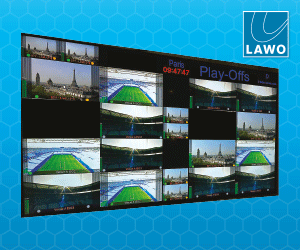As consumers viewing habits continue to change with second screens becoming more prevalent, broadcasters need to adopt smart strategies to monetise content thats available to them, says Johann Schreurs As smart devices, such as smartphones, tablets, smart TVs, and so on become ubiquitous, content consumption via the small screen is becoming more common. Watching content on […]
As consumers viewing habits continue to change with second screens becoming more prevalent, broadcasters need to adopt smart strategies to monetise content thats available to them, says Johann Schreurs
As smart devices, such as smartphones, tablets, smart TVs, and so on become ubiquitous, content consumption via the small screen is becoming more common. Watching content on TV while engaging in related social media activity or viewing at the same time is becoming a norm sooner than you would think. This is particularly the case among younger viewer demographics. eMarketer (a market research company covering digital media) forecasts that in 2013 the number of internet-connected devices shipped will cross 1.5 billion, while analysts at Deloitte have predicted that around 10% of households in developing markets will dual screen their TV consumption each month during the course of this year.
The mushrooming of over-the-top (OTT) services (such as Netflix and BBC iPlayer), the provision of PVRs by pay-TV providers which enable time-shifted viewing, and the availability of content via sites such as YouTube as well as via a plethora of apps, have all combined to reshape consumers viewing habits. Audiences are no longer confined by linear viewing dictated by a broadcasters schedule; consumers are now the remote controllers, creating individual viewing patterns that fit in with their lifestyle. With so many avenues for content access now available to them, viewers are also much more proactive about discovering and watching media via a variety of devices, at a time and location that suits them.
With so much competition for viewership, broadcasters are increasingly concerned about how to keep viewers on platform or on brand as opposed to looking to third party content via their various companion devices.
In the last two years weve increasingly seen broadcasters begin to curate and deliver additional content including news, live streams, aggregated twitter feeds, etc. via their own online portals and apps. This is especially the case with sports and live event broadcasting, where second screen viewing is particularly relevant. The London 2012 Olympic Games were a prime example of this; the event saw the highest consumption of digital content on record via a range of smart devices. At the same time, mobile operators like Vodafone reported their highest volume of data usage in 40 years when the games reached their peak on Super Saturday.
Sports have always led the way when it comes to online and mobile access. Sports fans are the early adopters of consumer trends such as multi-task while watching live TV, making use of companion devices (usually smartphones and tablets) to access associated Twitter feeds, player stats, and so on. Research by social TV analytics company, Trendrr, found that sports and special programming (such as live coverage of the Oscars) accounted for almost 60% of second screen activity in the first quarter of 2013. Sports broadcasters such as ESPN and Al Jazeera Sports are looking to capitalise on these trends. It is now common for a sports broadcaster to offer app-based content to augment the viewing experience the ESPN ScoreCenter and Al Jazeera Sports apps, for example, provide access to curated Twitter feeds, news, statistics, live streams, and so on to feed the insatiable appetite for additional, relevant content.
At the moment, these app-based services tend to be offered free, as part of a wider pay-TV subscription that includes premium sports channels. However, by creating more enriched and compelling content, broadcasters will be able to better monetise these second screen offerings. This could either be via targeted advertising or by offering access to these apps on a standalone subscription or on a pay-as-you-go service basis to non-customers.
Telcos already do this with their bundled content services especially their streaming music offerings.
However, at a time when broadcasters are more conscious than ever of trying to do more with less, the prospect of investing in additional content creation for second screen access is a challenge. In todays economic climate, its all about trying to avoid investment in new content and be as creative as possible with their existing assets. This might sound like a tall order, but with the right technology in place, broadcasters can make use of their existing media assets to generate exclusive content and then deliver it via these apps to smartphones and tablets.
Live coverage of football games provides a perfect illustration of how this can be achieved. During a live broadcast of a Series A or Champions League game, its not unusual to have more than 20 cameras, positioned around the pitch and stadium. The result is that several hours of footage are generated, but normally a significant amount of content from a live broadcast production ends up being wasted. Only a small proportion of all the content captured during a football match will actually make it to air for every 90 minutes of material viewed on a television screen, about 26.5 hours of content will never see the light of day.
There is so much more that can be done with this additional, unused content to create an enriched live production. This unused footage is perfect for populating second screen apps, providing exclusive content and enhancing interactivity something that broadcasters will increasingly have to do in order to create differentiation as the competition for viewers eyeballs becomes fiercer. However, with costs as a priority, the challenge is to make use of this wasted resource without a major investment in a whole new second screen production workflow.
With the right tools and technology, already available in the market, broadcasters can put their existing content assets to use more effectively. More importantly, this can be done without having to overhaul their entire live production workflow. A simple addition to an existing workflow is all it takes for a broadcaster to be able to deliver additional, exclusive not to mention compelling content to viewers via smartphone and tablet apps. From the viewers perspective it makes their second screen a true companion device allowing them to choose replays or goals, saves and other highlights from multiple camera angles as well as continue to benefit from existing app-based content.
Several broadcasters have already taken steps to make more effective use of the live sports content, delivering content that does not make it to air via the second screen. Frances Canal+ and Sky Sports in the UK are just some of the broadcast players that have taken the first steps to enhance their live sports coverage. Football is one such example where live viewing experience is enhanced with additional content that has already been ingested as part of the live production process.
The most recent incarnation of the Sky Sports app made its debut at the Champions League final in May 2013, between Borussia Dortmund and FC Bayern Munich. The app now includes
the Sky Sports 360 feature, providing multicam action replays (including Super Slow Motion).
App-based content delivery is set to become mainstream, so these broadcasters are ahead of the curve and well placed to capitalise on this trend.



































































